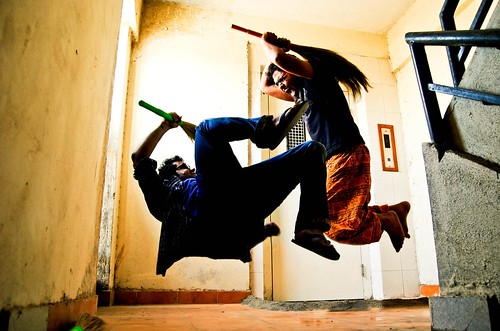 |
| Photo credit: Anant Nath Sharma on Flickr |
It’s not that I don’t want my characters to ever get along, in fact, it’s important that those who are meant to work together learn to at the very least tolerate each other. But if you make the relationships between your main characters too easy, you’ll be missing out on major potential for tension and conflict.
One of the easiest ways to keep your story interesting, even between the more exciting, edge-of-your-seat scenes, is to administer a tension transfusion. A simple scene of two characters sharing the same space with nothing particularly interesting going on can become fascinating if one character is secretly angry at the other, of if they’re both openly angry, or if one character recently hurt the other, or if they’re irritated at each other, or…
I think you get the idea.
Tension between characters can be used in just about any situation and is a great way to add an underlying thread of conflict to be woven into your story.
Here’s a quick example from City of Ashes by Cassandra Clare. After an incident I’m not going to spoil, but I will say involves fighting and people getting hurt, Clary (the protagonist) is assessing the situation and calming down when Jace (the sort of love interest) and company come onto the scene. Jace and Clary, at this point, are not getting along, and so what would have been an otherwise relatively calm (in comparison, anyway) scene is rife with tension:
“‘What,’ [Jace] said, with a sharp and deliberate annoyance, ‘do you think you’re doing?’Very quick example, as I said, but the banter is significantly more interesting if only because Jace is furious with Clary to begin with, so when he arrives he brings with him a whole new wave of conflict.
Clary glanced down at herself. She was still perched on the coffee table, knife in hand. She fought the urge to hide it behind her back. ‘We had an incident. I took care of it.’
‘Really.’ Jace’s voice dripped sarcasm. ‘Do you even know how to use that knife, Clarissa? Without poking a hole in yourself or any innocent bystander?’” (City of Ashes, page 231)
Tension between characters, to me, is always fun to write, and it’s a quick, easy way to inject some conflict into any scene.
Have you used this method to include tension in your scenes?
Twitter-sized bites:
Do your characters get along too well? You may be missing out on potential tension and conflict. (Click to tweet)
Looking for a way to add tension do your WIP? Writer @Ava_Jae shares a quick way to add conflict. (Click to tweet)








5 comments:
Tension really brings out the contrasts in character personalities. The main love interest for my protagonist got on her nerves with his charm and goofiness in the beginning, but it was more sexual tension than anything. But once he "disappears" and I introduced a character who was way more serious and wary of the protagonist, it's like you could feel the distrust between them, and the compatibility between the protag on her love interest only appears stronger in comparison. I'm not making any sense, haha.
My protagonist has a partner-in-crime/almost co-protagonist with whom he is plotting something huge. I noticed I was bored whenever they stood around and amiably plotted. I changed my approach, and now they either debate/bicker about the best approach, or one of them will deliver bad news about a hurdle they've encountered, and the two will experience a unified "oh, shit" moment. In the latter example, we see tension, but because it comes from the outside, we get to see the two characters bond as they deal with it. It replaces the "Mutual Admiration Society" aspect of two people always (boringly) working well together. They're getting along as they talk about "what to do" about the outside threat, but you still have tension because of that threat. (And we might even like them better because characters have more personality when they are arguing. Debate also allows you to show personality differences between two people who normally get along.)
Meanwhile, since conflict is the best way to expose new information, I also use these devices to drive the story (and plot) forward by throwing in key facts that are at the center of the debate or hurdle. It's a three-fer. Create conflict, show characters bonding as they fight each other but still come up with a resolution, and drive story, all in one in scene or moment.
Oh so true. The story more or less IS the characters, and being people they're hypersensitive to what's going wrong and tend to show it.
In fact, I think any scene tends to jump ahead to whatever conflict is there, or at least talking *about* the hard choices. Even if people are barely arguing at all, they'll agree on three things and got stuck on the fourth-- because non-conflict just isn't the important part, to characters OR to readers.
Call it the "speed bump or speed by" perspective.
That's another good method. I like to put my characters at odds and force them to learn how to work together, which doesn't seem to be too different from what you describe with the debating and bickering. But being able to crete conflict, have your character relationships grow (or develop, at least) and driving the story forward at the same time is fantastic. :)
I think the scene should often jump ahead to conflict or tension of some kind (and in edited, polished works, most times that's the case). Sometimes in first drafts that's not always the case, but it's definitely something to strive for.
Post a Comment